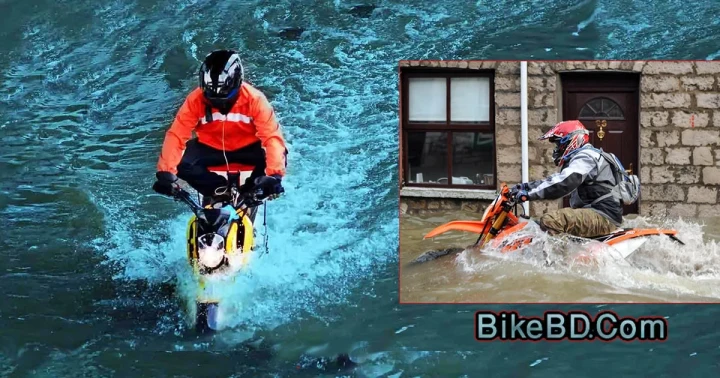What to Do if Your Motorcycle Gets Submerged in Floodwater?
This page was last updated on 15-Oct-2024 04:43am , By Saleh
In a country like Bangladesh, here seasonal changes are very common, and sudden flooding during the rainy season is a frequent issue. Due to the siltation of rivers and canals, heavy upstream rainfall easily causes floods in low-lying areas, therefore, it submerges many of our homes. Along with homes, many of our motorcycles are also partially or fully submerged in the flood waters. Hence, here in this discussion, we will cover what to do if your motorcycle gets submerged in floodwater.

What to Do If Your Motorcycle Gets Submerged in Floodwater?
Generally, if a motorcycle is submerged in floodwater or standing water up to a certain level, it doesn’t cause significant damage that much. In such cases, you can ride the motorcycle out of the water quickly. So, if the floodwater level stays below the motorcycle’s air filter inlet, exhaust valve or header, and spark plug level, the motorcycle can be driven. In such cases, even if the exhaust muffler is submerged, it usually doesn't make any problems. But, if the water level reaches or exceeds these points, one should not attempt to ride the motorcycle.
In such cases, if your motorcycle remains submerged in water for some time, you should take certain precautions before trying to start it. If the motorcycle has been submerged deeper than the above mentioned levels for a long time, specific precautions must be followed before starting it again. Otherwise, attempting to start the motorcycle in such situation can cause significant damage. So, to avoid any damage let's explain what to do if your motorcycle remains submerged in deep floodwater.

Assessing the Damage of the Motorcycle
If your motorcycle gets submerged in floodwater, at first get the motorcycle out of the water and keep it in a dry place. Afterward, inspect it thoroughly to determine how deeply it was submerged. If it was submerged below the safety level, like below the air filter inlet, exhaust header, and spark plug level, you can start the motorcycle after doing basic cleaning and lubrication of various parts of the motorcycle.

However, before starting the motorcycle again, it is necessary to check the battery, electrical lines, and brakes first. But, if the motorcycle was submerged above the safety level or for a longer period, then a extensive service is necessary. This service and maintenance can be done by yourself or can be done at a regular workshop. So, let's take a look at the steps to take to get your motorcycle running again if your motorcycle has been significantly submerged in the deep floodwater.
>> If a motorcycle is submerged in the floodwater beyond its safety level, get it back from the water and take it to a dry place. Do not try to start the engine just on that time, as this could cause significant damage.
>> Secondly, disconnect the battery immediately to avoid any short circuit. Clean and dry the battery and ensure it is charged properly.
>> Then clean the motorcycle as thoroughly as possible and allow it to dry. Also, remove body panels and check the electrical wiring thoroughly.
>> Use an air blower to remove water from the electrical wiring and other components and dry those. Also, clean and repair any loose connections or corroded areas before reconnecting the battery.
>> Next, remove the air filter element to check if water has entered the filter box. If water is present there, dry it out and replace the air filter it with a new one. For carburetor bikes, also open the drain nut and drain the carburetor thoroughly.
>> If the motorcycle was submerged up to the fuel tank, also drain all the fuel and dry the tank thoroughly before refilling it with fresh fuel. For carburetor bikes, drain the carburetor with the new fuel at the same time.
>> In the meantime, also remove the spark plug to check its condition. If in doubt, replace it. Before installing a new plug, let the plug hole open for a while to allow the combustion chamber to dry to be in the safe side.
>> Again, to prevent the piston from jamming against the cylinder wall pour a few drops of engine oil through the plug hole as a precaution.
>> Next, check if water has entered the engine's crankcase by draining the engine oil. It is very important. If the drained oil appears milky, it indicates water somehow entered inside.
>> If water has entered into the engine, drain all the engine oil and use pressurized air to remove as much oil and water from the engine as possible. It’s also recommended to use engine flush oil once and then, install a new oil filter and fill the engine with fresh lubricating oil.
>> Finally, after filling the engine with fresh oil, ensure the battery and electrical connections are properly secured, then start the engine. If the motorcycle has a kickstarter, it’s better to use that first.
So, dear friends, these are the general procedures to follow if your motorcycle gets submerged in deep floodwater and make the motorcycle operable again. Usually, this will make the motorcycle operational again unless any electrical parts have been damaged. However, if the motorcycle remains underwater for an extended period, it is advisable to take it to a good service center or mechanic for a thorough inspection and service.
Prolonged submersion in floodwater can make severe damage to the motorcycle's electrical components, cables, brake setup, transmission system, pivot bearings, and other metal parts. In such cases, a full service is really necessary to restore the motorcycle to get it in full working condition. This will also give you peace of mind regarding your beloved vehicle's performance and you will be worry free, that’s it.













